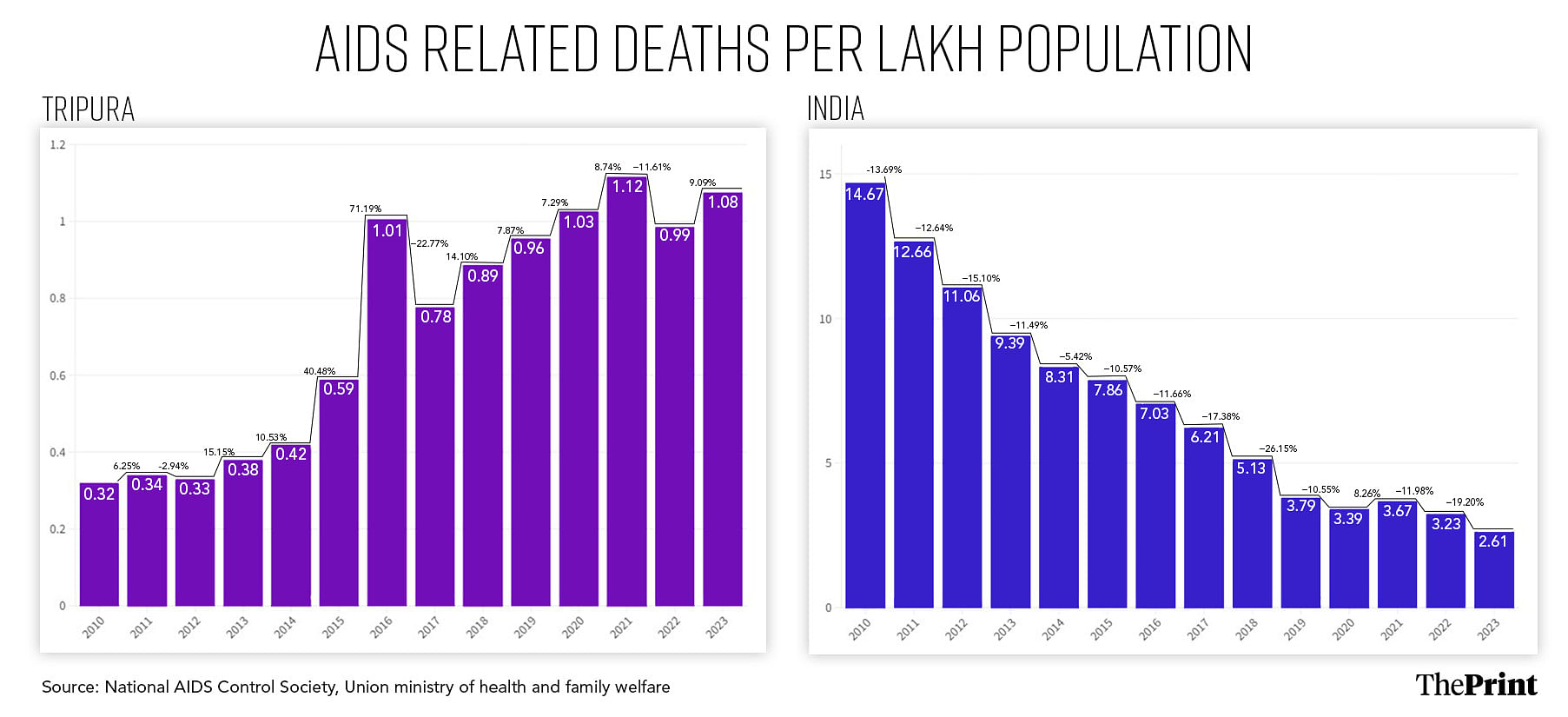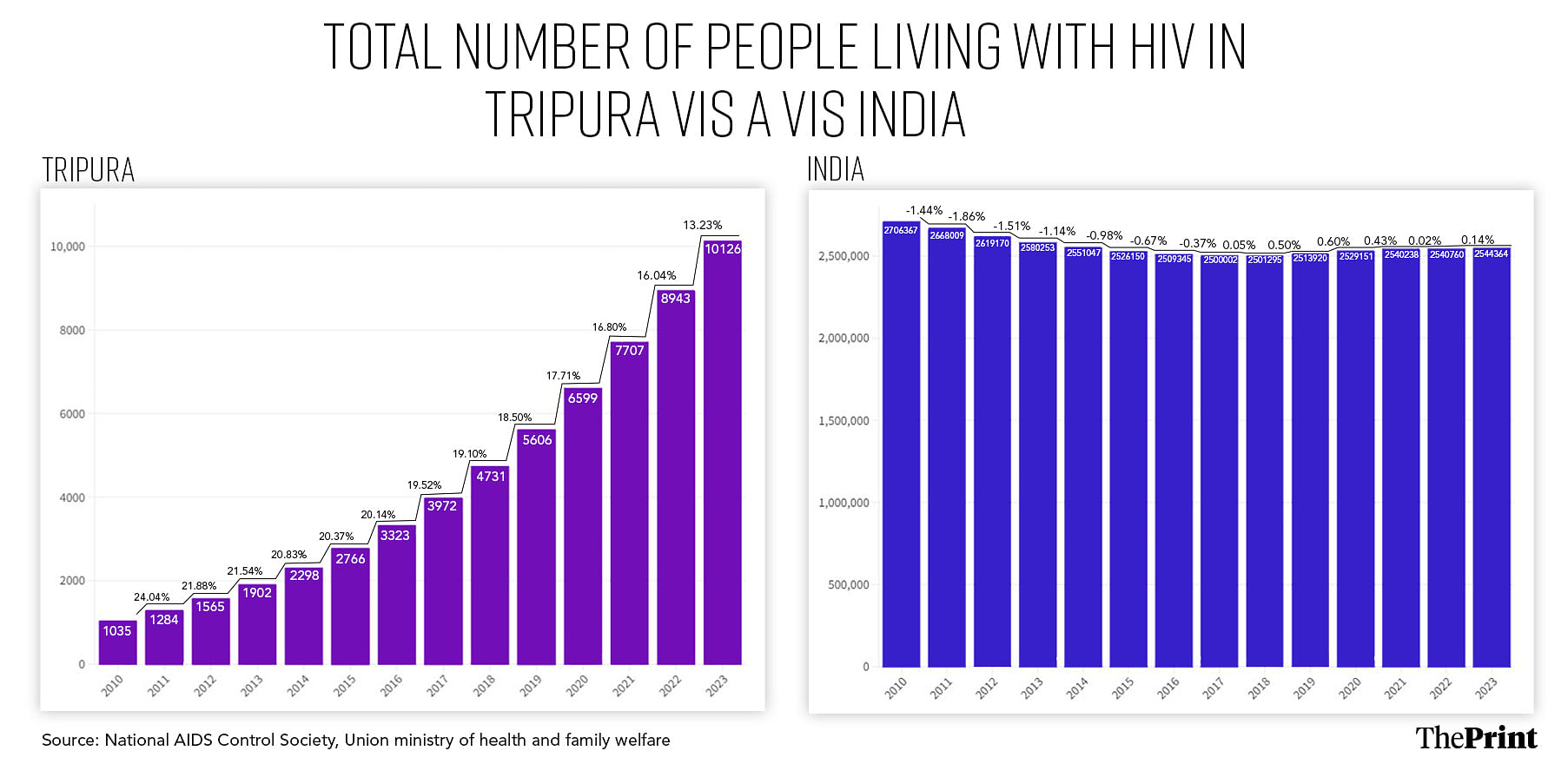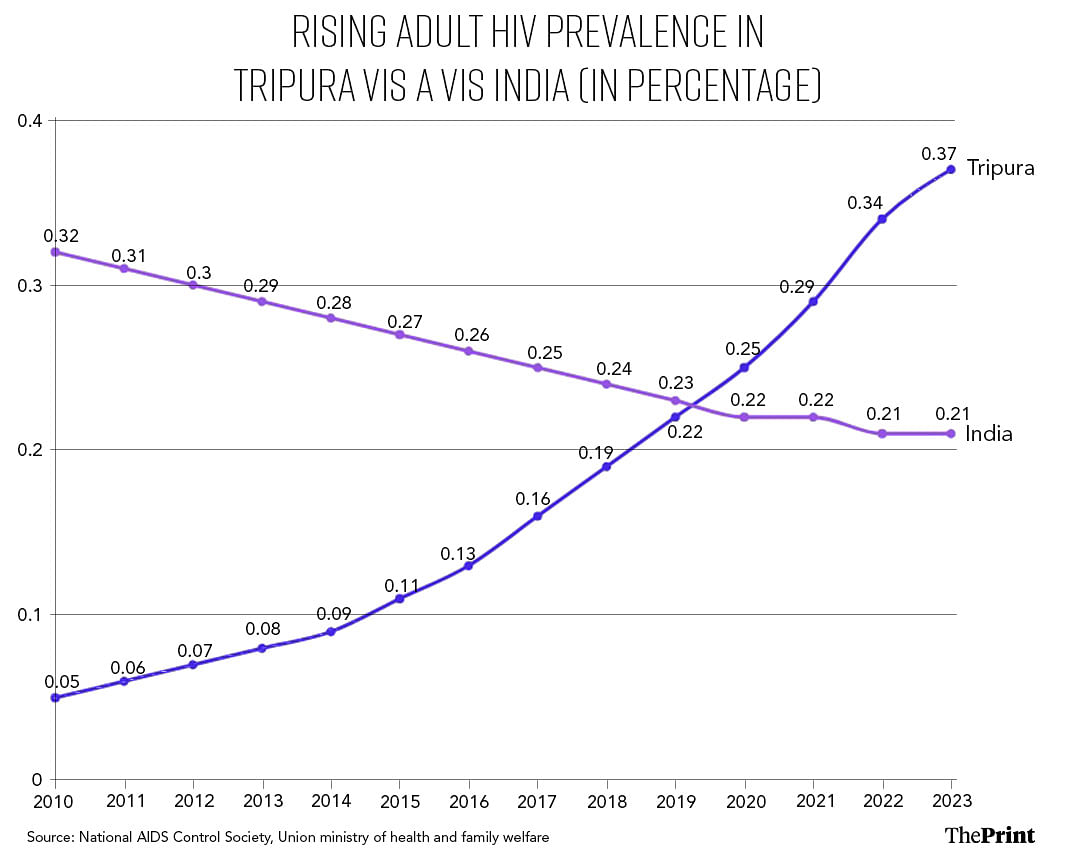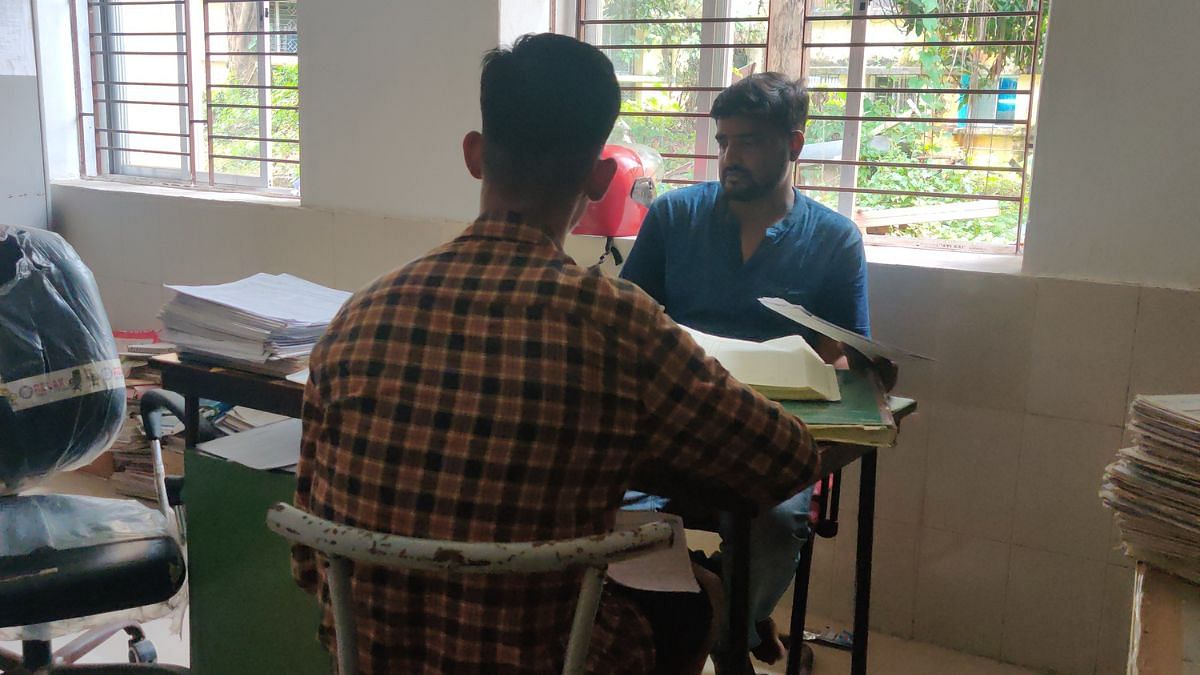It’s not just him, a large number of youth in Tripura remain bound by a common thread — an HIV infection following sessions of sharing needles to inject heroin. Globally, sharing needles to abuse drugs is among the top causes for the spread of HIV, a virus that destroys immunity cells in the body.
According to government data, Tripura has seen the highest rise in the rate of annual new HIV cases, as well as the highest rise in the rate of AIDS-related mortality between 2010 and 2023.
This is the first of ThePrint’s two-part series that looks into the rise of HIV cases in Tripura and the state’s response to the public health challenge, and further examines the current status of India’s National AIDS Control Programme.
Almost as easy as buying eggs
Buying heroin is nearly as easy as buying eggs in most parts of Tripura now, if one knows the ‘right person to approach’.
A spurt of quick HIV transmission among IDUs — which may have started years ago in the hilly northeastern state, one of India’s smallest — has now turned into a wildfire.
Both statistics and anecdotes are a testament to this.
According to the HIV Estimate Factsheet 2023, published in June this year by the National AIDS Control Organisation (NACO), a division of the Union health ministry, Tripura has seen the highest rise in the rate of annual new HIV cases, with this rate increasing by nearly 524 percent between 2010 and 2023. In the same period, the overall rate of annual new infections in the country dipped by 44.23 percent.
The factsheet also shows that Tripura registered the highest rise in the rate of AIDS-related mortality between 2010 and 2023 — 300 percent. The overall rate of AIDS-related mortality in the country declined by nearly 80 percent in the same period. Acquired Immunodeficiency Syndrome (AIDS) is the late stage of HIV infection.

In terms of absolute numbers, the figures may still seem low — Tripura registered 1,330 new HIV infections and 44 AIDS deaths last year. But, for the small state, which had low baseline figures in 2010, it’s still a burden too heavy.
In 2010, Tripura had 1,035 people living with HIV (PLHIVs). In contrast, this number stood at 10,126 in 2023, with most infected people aged under 30 years.
“The statistics from Tripura look gloomy. At this rate, the state is likely to soon leave behind other places where the HIV burden has traditionally been high,” said Dr Ishwar Gilada, the president emeritus at the AIDS Society of India.

Also read: Focus on 113 home-grown, affordable medical devices to cut down import dependence, says govt
New battle lines for youth, families
The parents of the 22-year-old patient mentioned earlier, knew he was stealing money to procure drugs. They put him in a rehab centre in an Agartala suburb in 2022.
Initially, the family, including a younger sister, would visit him on occasion. For the young man, these visits brought hopes of a reconciliation with his family after getting clean.
These hopes, however, were dashed after a screening procedure for IDUs at the centre. He tested HIV-positive.
His father declared that the man could not return to his family home and stopped his mother and sister from maintaining contact.
“After I had been clean for a while, the centre wanted me to return to my family, but I had nowhere to go. I somehow found a way to this new rehab centre, where I like it better,” said the 22-year-old, now clean for several months and on routine Antiretroviral Therapy (ART), a treatment for HIV patients.
For him, the challenge is multi-fold now — constant efforts to stay away from heroin, navigating life as an HIV patient, and the pain of being abandoned by loved ones.
For the last two months, he has been staying at Rupayan Foundation, a rehab centre for drug and alcohol addicts in the heart of Agartala city.
Around a kilometre away from Rupayan, is the ART centre at the Agartala Government Medical College and Govind Ballabh Pant Hospital (AGMC), the largest public health facility in the state. A pharmacist, who has been administering Antiretroviral Therapy at the centre for the last 15 years, says that on most days, he is overwhelmed by the sheer volume of patients coming in.
“When I joined here in 1999, four to five patients would trickle in during the entire day. Now, it’s roughly 120-130 patients every day, a majority of them with a background of drug abuse,” he said.
The stark difference, the pharmacist, who did not want to be named, said, became visible during the COVID-19 pandemic when hardly any HIV patients were coming in for treatment.
A 20-year-old, who receives treatment at the ART centre in Indira Gandhi Memorial Hospital, the second largest government hospital in the state after AGMC, said he started injecting heroin two years ago at the behest of his college friends.
“My friends would gather every day in the evening, and they would play, listen to music, and pass around drug-filled syringes. They used to call themselves blood brothers, and I wanted to be in that gang too,” he said.
In late 2022, he was diagnosed with HIV infection.
From a business family, the 20-year-old now constantly worries about how to keep his HIV diagnosis hidden from his relatives. “My immediate family knows about it. But, all hell will break loose if other relatives come to know. I am unsure how long I can keep it hidden.”
Facing prejudices, stigma and an uncertain future, hundreds of other young adults and adolescents in the state have similar stories. Tripura witnessed a consistent rise in the IDUs, especially in the last few years.
And, this trend has led to another unwanted challenge for the state, which shares nearly 90 percent of its border with Bangladesh, and the remaining 10 percent with Assam and Mizoram.
HIV progresses to AIDS, which, though considered a largely chronic and manageable health condition, can without proper or regular treatment trigger tuberculosis, severe bacterial infections, and cancers such as lymphomas and Kaposi’s sarcoma.
Also read: India logs third highest number of children not vaccinated against measles after Nigeria and Congo
‘If pattern continues, Tripura will leave Manipur far behind’
For a long time, India has been applauded for successfully curbing HIV/AIDS — which threatened to create public health havoc in the 1990s — primarily through the inclusion of free ART in the National AIDS Control Programme (NACP), as well as widespread public awareness campaigns.
But India still had 25.44 lakh PLHIVs in 2023. This is among the highest numbers globally, higher than the numbers in some African countries worst affected by the disease.
According to experts and authorities, the rise of the disease in some states, such as Tripura, among a few others, threatens to rock the country’s status on the HIV/AIDS front.
Tripura is one of five states that have seen an increase in annual new infections between 2010 and 2023. Besides Punjab, the others are Arunachal Pradesh, Assam, and Meghalaya in the North East.
In Tripura, the adult HIV prevalence grew from 0.05 percent in 2010 to 0.37 percent in 2023, among the highest in the country. AIDS-related deaths grew from 0.32 per lakh population to 1.08 during this period.

The concerning rise of the epidemic in Tripura comes in the backdrop of the widely prevalent abuse of injectable drugs and subsequent health consequences in the neighbouring states of Mizoram, Manipur, Arunachal Pradesh, and Nagaland.
But, while the epidemic appears to be declining in the neighbouring states, including Manipur and Mizoram, the two northeastern states known for HIV infections among the young, the situation is becoming gloomier by the day for Tripura.
“The trend of rising HIV infections (in the state) is indeed worrying,” Dr Samarpita Datta, project director of the Tripura State AIDS Control Society (TSACS), told ThePrint.
“What’s even more concerning is those aged 15-24 years getting increasingly infected. This changes the course of their lives, and for a tiny state like ours, it means a huge burden on the resources because they would need lifelong ART therapies,” she added.
Nearly 70-80 percent of the new infections are detected in those under 30 years of age, Datta added.
While the prevalence of PLHIV in Tripura is still far lesser than in Mizoram, which, at 2.73 percent, has the highest PLHIV prevalence in the country, the trend, according to experts, seems to be reversing.
“If the pattern continues, Tripura will leave Mizoram far behind in just a few years,” said Gilada.
According to TSACS figures, the state registered 828 students as HIV-positive between 2007 and 2022, and 47 of them succumbed to the illness. However, the number of IDUs, who have HIV, could be far higher because not all IDUs, even if young, are enrolled in schools or colleges.
Additionally, the major worry for the state is that the infection will not stay limited only to IDUs. The virus is known to spread quickly between sexual partners during unprotected sexual intercourse and from infected pregnant women to unborn babies as well.
Dr Glory Alexander, a Bengaluru-based AIDS specialist, said that the scenario in NE states, mainly Tripura, is “extremely worrying”.
“The central and state governments need to take the issue seriously and tackle the crisis immediately. India has a robust curative programme for HIV/AIDS, but the NACP, in these states, should step up efforts to stop the new infections,” she said.
Tripura is the third smallest state in India by geography. Its population — 37 lakh, according to the 2011 census — is among the lowest for an Indian state.
“As such, the threat of HIV infection rising quickly within the general population is high,” said Alexander.
This threat has been acknowledged even in the government echelons.
“In Tripura, annual new HIV infections in 2022 increased by 300 percent times vis-à-vis 2010. Similarly, in Arunachal Pradesh, annual new infections increased by roughly 200 percent, in Meghalaya by 150 percent, and in Assam by 75 percent. The level and trend of HIV prevalence and incidence in the northeastern states is alarming,” said NACO’s 2023 Sankalak report on the national status of AIDS.
ThePrint reached V Hekali Zhimomi, director general, NACO, over phone and emails for comment on the growing HIV crisis in the state. This report will be updated if and when a response is received.
Also read: With AIIMS Delhi set to train surgeons in face transplant, a look at the procedure & risks involved
Crisis on many fronts
At Kulai District Hospital in the Dhalai district, an official said that the district, located nearly 100 km east of Agartala, has been among the hardest hit in terms of the numbers of IDUs and HIV patients.
The hospital is among the state’s seven public health facilities, where ART is dispensed to HIV/AIDS patients.
A 25-year-old patient, who had come to the centre to collect his medicine and get a viral load test, that is, a blood test to measure the amount of HIV in a patient, said he was diagnosed with the disease four years ago, following months of injectable drug use.
“I am constantly worried about catching opportunistic infections such as hepatitis B and C because I don’t keep well generally,” he said.
The ART centre at the hospital nowadays sees 20-25 patients daily.
“Many of them are on the second and third line of the treatment, and several are also undergoing treatment for tuberculosis because Dhalai was among the first districts in the state to see a high number of IDUs due to its proximity to Mizoram, from where heroin enters the state…. Their lives are in shambles, and it all started with them getting hooked on injectable drugs,” the official said.
According to Pronab Deb, project manager of Prabaha, an NGO working in the area of HIV/AIDS in Dhalai, the district, to some extent, has seen a stabilisation in the number of annual infections.
“But, while earlier, the menace of HIV and IDUs was largely limited to North Tripura and Dhalai, now all districts are affected. Among the worst hit are Khowai, West Tripura (Agartala city is its district headquarters), and Sepahijala,” he said.
In Khowai, according to information accessed by ThePrint, 94 percent of the new infections last year were among IDUs — the highest in the state. Sepahijala closely follows Khowai, where this figure stands at 93 percent.
NACO estimates that the HIV prevalence among the high-risk groups continues to be much higher than the overall HIV prevalence.
In comparison to the estimated national HIV prevalence of 0.20 percent among adults in 2022, the observed prevalence among high-risk groups is nine to 43 times. The observed prevalence is 1.85 percent among women sex workers, 1.93 percent among inmates in central jails, 3.26 percent among men who have sex with men, and 3.78 percent among transgender persons, according to the 2023 Sankalak report.
However, at 9.03 percent, it is the worst among injecting drug users (IDU), according to the government document. No wonder, then, Tripura, grappling with burgeoning IDUs, has another monster to deal with.
“Heroin is now accessible to anyone, anywhere, in most parts of Tripura, and a large number of grocers, stationers, and e-rickshaw pullers seem to be into peddling heroin or its cheaper version, an extract that costs Rs 40-60 per vial, called kouto (container) in Bangla,” said Malyaban Chakraborty, who runs Rupayan Foundation.
His centre has 64 inmates, and 13 of them are HIV-positive. Chakraborty said that even though he does not want to, he has to refuse admission to many addicts, mainly due to fund shortages.
“People used the term Udta (flying) Punjab earlier. It’s Udta Tripura now. There are drug addicts everywhere, and the situation is quite scary in educational institutes,” he added.
That heroin and other narcotics are making it into the state easily is acknowledged by top administrative officials in the state.
“Many NE states share a border with Myanmar, a country in the Golden Triangle. Over the last several years, the narcotics crisis has also hit Tripura, which receives the highest amount of drugs in the country due to its proximity to the drug transport route,” Amitabh Ranjan, director general of police in Tripura, told ThePrint.
Parts of Myanmar, Laos and Thailand fall in the Golden Triangle — one of the largest opium-producing regions in the world — and the four NE states of Arunachal Pradesh, Mizoram, Manipur, and Nagaland share a border with Myanmar.
Tripura, on the other hand, shares its border with Mizoram, a major transit route for narcotics.
Tripura, Ranjan said, also destroys the largest amount of drugs every year in the country and taking cognisance of narcotics reaching youngsters easily is facilitating measures to curb its spread.
“Several departments have come together to spread awareness about preventing drug abuse and resulting health issues among our kids,” Ranjan said.
Subhrajit Bhattacharjee, joint director (information, education and communication), TSACS, pointed out that Tripura, in March this year, became the first state in the country to mandate that all schools, colleges, and educational institutes conduct a weekly session on the menace of AIDS and its probable transmission, especially through drug addiction.
“TSACS has informed that a good number of school and college students are affected by HIV/AIDS — which is not desirable at all,” said the memorandums issued by the directors of the secondary and higher education departments to the institutions.
This is a good initiative, said the 20-year-old HIV patient, who is from a business family, when asked to share his views.
“Maybe I would have been more cautious had it started a couple of years ago,” he said.
(Edited by Madhurita Goswami)
Also read: 3 imported cancer drugs made duty free, but cold shoulder to health sector overall in budget

